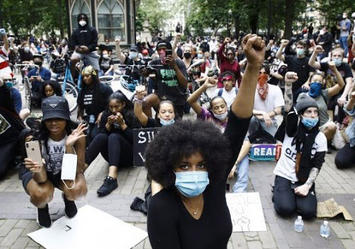
It's time to put the current protests revolving around the Minneapolis police killing of George Floyd in the appropriate emotional and historical context. More importantly, it's time to consider what comes next.
I know I'm not the most impassioned man. I'm pretty good at dispassionately looking at data, analyzing, finding connections and making conclusions. But I'm not immune to the pain, anger and outright rage that people are expressing nationwide. Witnessing the life seep away from George Floyd, over nearly nine excruciating minutes... it's incredulous. Words simply cannot explain the depth of the hurt I feel.
Every time this happens I realize full well it could be me. It is me.
And the aftermath -- more than a week of peaceful but vigorous protest, oftentimes devolving into violence perpetrated by protesters and police alike -- seems like a watershed moment in our society.
What we're seeing now is at a scale not seen in the last 50 years. Not since 1968, as the nation's inner cities reeled after the assassination of Dr. Martin Luther King, Jr., have we seen protests at this scale. Sadly, we're seeing it for the same dismaying reasons -- the blatantly unfair and unequal treatment of black people by police. It's killing us.
Most readers here know I grew up in Detroit. My earliest memory is of the 1967 Detroit riots. I was a small 2 1/2 year old child, and I remember being held in my mother's arms on my grandmother's front porch as we watched tanks roll by. But just as importantly I remember the decades-long collapse of the city in the riot's aftermath. So I feel I'm qualified to comment on this.
Let's go back to the Civil Rights Movement to consider where we are now. I've long believed the Civil Rights Movement accomplished the goals it initially set out to accomplish. The Civil Rights Movement took on the Jim Crow laws of the South that established second-class citizenship for blacks -- separate schools and facilities, impossible barriers to voting, explicit discrimination that prevented upward economic mobility. The Civil Rights Act of 1964, Voting Rights Act of 1965 and Fair Housing Act of 1968 are the hallmarks of the Movement.
But at the same time, more and more blacks were leaving the South because of the very conditions they were subjected to, and moving to Northern cities. When they got there, they found better opportunities, but a society regulated by a different kind of social contract:
"I think most all Northeastern and Midwestern cities -- from Boston to Washington, and westward to the Twin Cities and St. Louis -- patented a policy of exclusion toward blacks for much of their history. The Great Migration was the first and greatest threat to the policy of exclusion, prompting legal, extralegal, and violent battles in virtually all of the cities within this area at some point in the 20th century.
Whereas southern states were explicit in their exploitation of slave labor to fuel the plantation economy from the settlement of this country, I think morally ambivalent northern states and their largest cities chose to avoid the thorny idea of slavery and black people in their midst. They first sought to exclude blacks, and when they no longer could do that, they sought to marginalize them."
Emphasis added.
This was entirely different from the social structure of the South, regulated by explicit laws. In the North it was about the interpretation and enforcement of laws -- who would be treated harshly or leniently -- with no difference in the actual laws themselves. It became about how the law was applied, rather than written. No law said that Northern city parks or schools in black neighborhoods should receive less funding than those in white neighborhoods, but they did. No law said that federal urban renewal money or federal interstate highway money should be used to explicitly clear out black neighborhoods, but they were. The institution entrusted with the interpretation and enforcement of laws, to maintain a policy of containment? The police.
The strategy was different, but the outcome and impact was the same. The Movement was ill-prepared for dealing with the Northern variety of segregation and was making its shift to dealing with it -- right at the time of Dr. King's death.
The riots in Los Angeles' Watts neighborhood in 1965 and the Newark and Detroit riots in 1967 were the precursors to the unrest of 1968. Each was a response to heavy-handed tactics and violence perpetrated on blacks by police. People, mostly black people, took to the streets and vented their frustration, demanding change. For the most part, America shrugged. Unable to come up with a workable solution to the Northern version of racism, most middle class whites voted with their feet and accelerated the white flight to suburbia.
Read the rest of this piece on The Corner Side Yard
Pete Saunders is a writer and researcher whose work focuses on urbanism and public policy. Pete has been the editor/publisher of the Corner Side Yard, an urbanist blog, since 2012. Pete is also an urban affairs contributor to Forbes Magazine’s online platform. Pete’s writings have been published widely in traditional and internet media outlets, including the feature article in the December 2018 issue of Planning Magazine. Pete has more than twenty years’ experience in planning, economic development, and community development, with stops in the public, private and non-profit sectors. He lives in Chicago.
Photo credit: globalnews.ca












